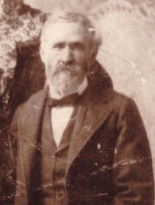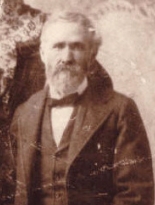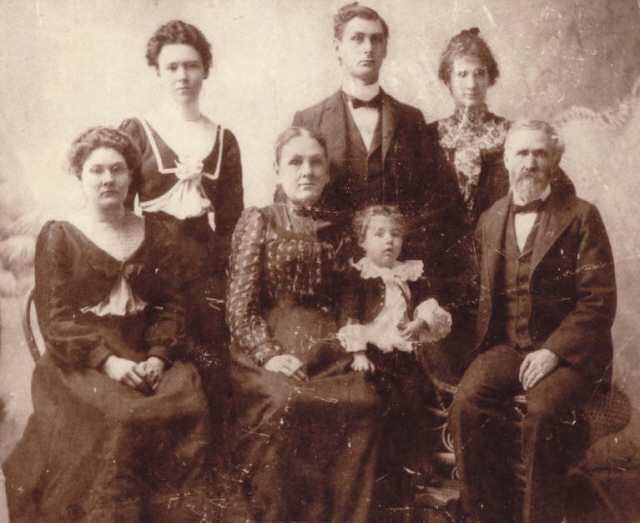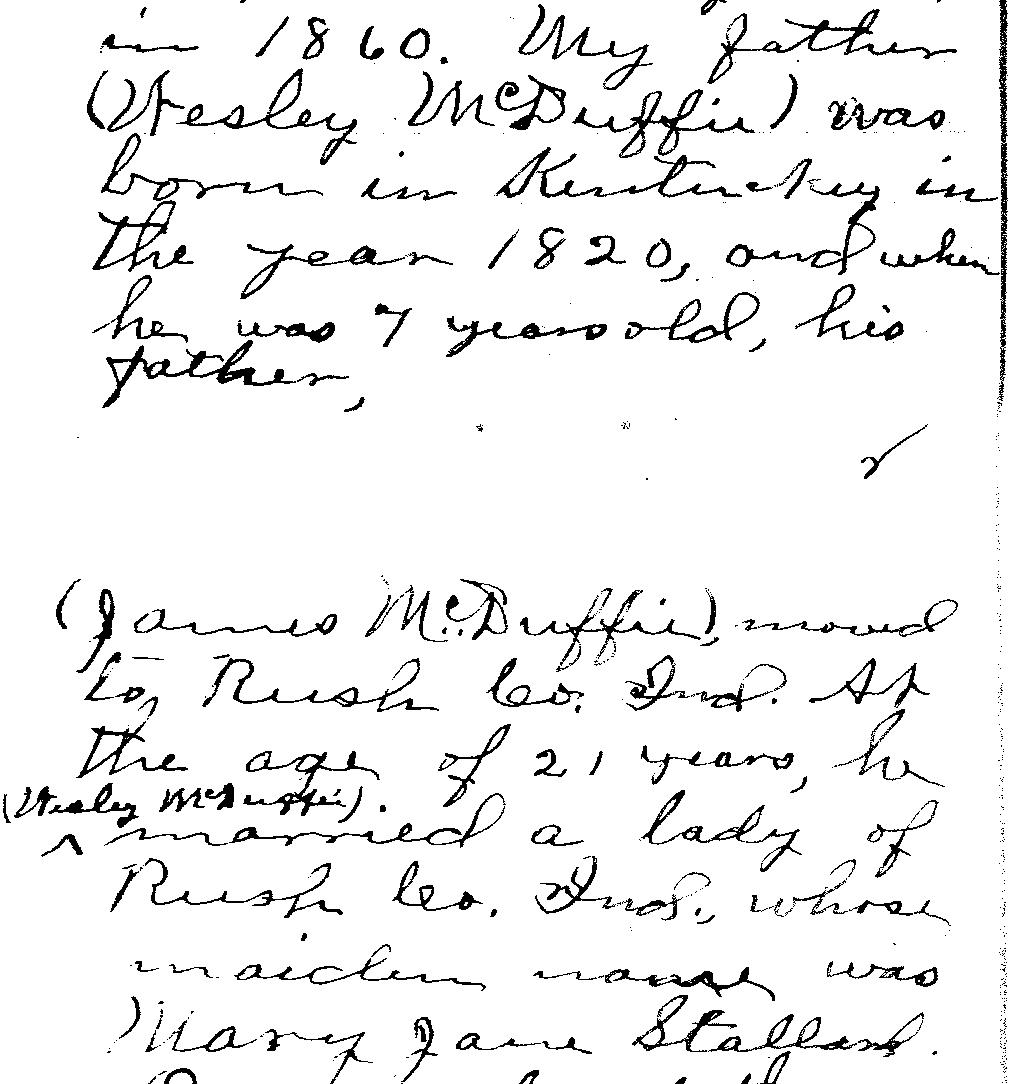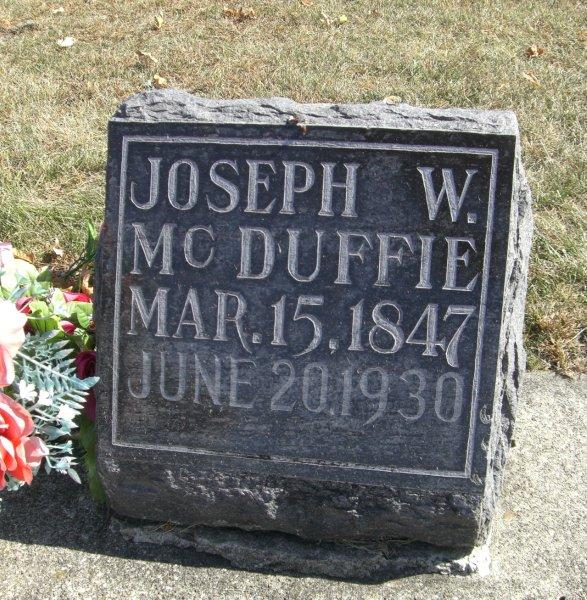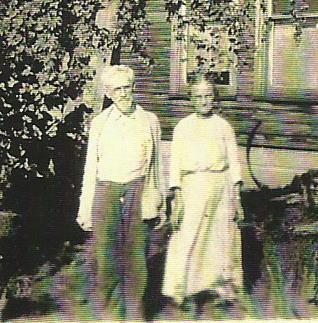After years of trying to piece our family together, I am reverting back to what my great grandfather, Joseph, wrote regarding his father's name and his grandfather's name. So much was written about the name John Robert that I did not come forth with this information, but I think it is telling and should not be overlooked. Take this for what it is worth, but those who knew Joseph (like my father Charles) said he was "sharp as a tack up to the day he died" - in other words, he was not senile. So, what he wrote in 1927, is accurate and true. I am typing his complete article and adding a piece of his handwritten notes to show that he indeed wrote it - and there are no cross outs or erase marks throughout his handwritten notes!
Berrien Springs, MI - 5 Dec 1927:
In the article of the Magazine Section of the South Bend Tribune for Sunday morning, 27 Oct 1927, we saw and read with interest the romantic story of Argus. I too lived in Marshall County, Indiana, at an earlier date than given in the article, in the matter of the time that W. J. Benner #40598659 taught his first term of school in 1860.
My father, Wesley McDuffie, was born in Kentucky in the year 1820. When he was seven years old, his father, JAMES McDuffie, moved to Rush County, Indiana. At the age of 21 years, Wesley McDuffie married a lady of Rush County whose maiden name was Mary Jane Stallard. On or about the same year, a sister of my mother, Jaela Rebecca Stallard, married Milton B. Hopkins. My mother had a brother that lived two or three miles east of Argus named Samuel Stallard, and another brother one and one-half miles southwest of Etna Green, but in Marshall County his name was James Axley Stallard. The Corey family are supposed to be relatives of the Stallard's. Jacob McClure Stallard of Lafayette, another brother and a noted preacher of Lafayette, has gone to his reward in heaven where there will be no more parting.
Now I return to my younger days. In the fall of 1850, my father Wesley traveled from Rush County to Marshall County to buy a home as well to visit. He found a farm of 120 acres three-fourths mile west of J. M. Stallard's that suited his liking for $400. He bought it and returned to Rush County. In the spring of 1851, he moved our family to our new home. The family consisted of the parents and four children. I am the third, a son four years old at this time. On arriving at the new home near 4:00 a.m., the first of April, and no house in which to sleep for the first night, father noticed a large tree lying on the ground a few rods away. On going to this tree, he found it to be hollow. At the butt, it was seven feet in diameter, a mere shell for some 16 feet. This opening we cleaned up and put in our bedding and slept in this for two nights. The next day, father rented a new log house, just finished, one mile north into which we moved for one month. When our new house was finished, we moved in the first of May, 1851. Then, I looked at the timber, timber, timber, stately black walnut and yellow poplar towering almost to the heavens above, and it seemed to reach west to the ancient Argos of old!
A log school house had been built three years before this, and one mile north. I started school at the close of my sixth year of age. The seats we sat on were nothing but slabs sawn from logs at the saw mill about ten feet long, flat side up with two holes bored at each end with pegs driven in 18 inches long and no backs. My feet, of course, did not reach to the floor and some of the pupils kept their feet swinging back and forth like a pendulum of a clock. For a writing desk, they bored holes in a round log in the room, put in pegs 20 inches long about five feet apart and laid a board 18 inches wide on the pegs to reach across the room. One on the north side for the girls and one on the south for the boys. The pens used were the old time goose quills. Our teacher's name was Maxwell. After attending school in the old log house for five terms, or in 1860, the patrons about 10 of them got together and voted to tear down the old school house and build a new and better one. But, due to the lack of money, they failed to get the new school house built for a period of five years. Then, for five years, I received no schooling.
When I reached 18 years of age, I entered school again and advanced fairly well to the age of 21 years. At this juncture, M. B. Hopkins (my uncle) was President of Howard College at Kokomo. His son, Alexander Campbell Hopkins was a teacher, and too, James I Hopkins, another son, was a teacher. So, I went to Howard College for several months and then to a special training school at LaPorte. Milton B. Hopkins was a wonderful teacher. He was also a good lawyer and preacher.
(Joseph W McDuffie)
'''''''''''''''''''''''''''''''''''''
Joseph was a land owner in White County, Indiana. He was the third child of 10 children born to Wesley McDuffie and Mary Jane Stallard of Rush County. Obviously, he was named after his mother's older half-brother (Joseph Whittenburg Stallard). When he was four years old, in the spring of 1851, the family moved to Argus, Marshall County, where his father bought a farm of 120 acres.
They remained in Argus nearly 14 years. In 1865, they moved to LaPorte County where he grew to manhood. On November 16, 1872, Joseph was united in marriage to Mary Ellen Mayes of Rush County. They located on a farm near Three Oaks, Michigan, where he followed the occupations of farming and school teaching. In the fall of 1876, he purchased a farm in White County, Indiana, near the town of Wolcott and remained there nearly 50 years.
Michigan Marriages, 1868-1925:
After Mary died, Joseph W., age 76, married Emma A (Joslin) Warren, age 63, on 21 Jul 1923 at Berrien Co, MI. Her parents were David Joslin and Rebecca Herbert. See photo of Joe and Emma or "Dell".
After years of trying to piece our family together, I am reverting back to what my great grandfather, Joseph, wrote regarding his father's name and his grandfather's name. So much was written about the name John Robert that I did not come forth with this information, but I think it is telling and should not be overlooked. Take this for what it is worth, but those who knew Joseph (like my father Charles) said he was "sharp as a tack up to the day he died" - in other words, he was not senile. So, what he wrote in 1927, is accurate and true. I am typing his complete article and adding a piece of his handwritten notes to show that he indeed wrote it - and there are no cross outs or erase marks throughout his handwritten notes!
Berrien Springs, MI - 5 Dec 1927:
In the article of the Magazine Section of the South Bend Tribune for Sunday morning, 27 Oct 1927, we saw and read with interest the romantic story of Argus. I too lived in Marshall County, Indiana, at an earlier date than given in the article, in the matter of the time that W. J. Benner #40598659 taught his first term of school in 1860.
My father, Wesley McDuffie, was born in Kentucky in the year 1820. When he was seven years old, his father, JAMES McDuffie, moved to Rush County, Indiana. At the age of 21 years, Wesley McDuffie married a lady of Rush County whose maiden name was Mary Jane Stallard. On or about the same year, a sister of my mother, Jaela Rebecca Stallard, married Milton B. Hopkins. My mother had a brother that lived two or three miles east of Argus named Samuel Stallard, and another brother one and one-half miles southwest of Etna Green, but in Marshall County his name was James Axley Stallard. The Corey family are supposed to be relatives of the Stallard's. Jacob McClure Stallard of Lafayette, another brother and a noted preacher of Lafayette, has gone to his reward in heaven where there will be no more parting.
Now I return to my younger days. In the fall of 1850, my father Wesley traveled from Rush County to Marshall County to buy a home as well to visit. He found a farm of 120 acres three-fourths mile west of J. M. Stallard's that suited his liking for $400. He bought it and returned to Rush County. In the spring of 1851, he moved our family to our new home. The family consisted of the parents and four children. I am the third, a son four years old at this time. On arriving at the new home near 4:00 a.m., the first of April, and no house in which to sleep for the first night, father noticed a large tree lying on the ground a few rods away. On going to this tree, he found it to be hollow. At the butt, it was seven feet in diameter, a mere shell for some 16 feet. This opening we cleaned up and put in our bedding and slept in this for two nights. The next day, father rented a new log house, just finished, one mile north into which we moved for one month. When our new house was finished, we moved in the first of May, 1851. Then, I looked at the timber, timber, timber, stately black walnut and yellow poplar towering almost to the heavens above, and it seemed to reach west to the ancient Argos of old!
A log school house had been built three years before this, and one mile north. I started school at the close of my sixth year of age. The seats we sat on were nothing but slabs sawn from logs at the saw mill about ten feet long, flat side up with two holes bored at each end with pegs driven in 18 inches long and no backs. My feet, of course, did not reach to the floor and some of the pupils kept their feet swinging back and forth like a pendulum of a clock. For a writing desk, they bored holes in a round log in the room, put in pegs 20 inches long about five feet apart and laid a board 18 inches wide on the pegs to reach across the room. One on the north side for the girls and one on the south for the boys. The pens used were the old time goose quills. Our teacher's name was Maxwell. After attending school in the old log house for five terms, or in 1860, the patrons about 10 of them got together and voted to tear down the old school house and build a new and better one. But, due to the lack of money, they failed to get the new school house built for a period of five years. Then, for five years, I received no schooling.
When I reached 18 years of age, I entered school again and advanced fairly well to the age of 21 years. At this juncture, M. B. Hopkins (my uncle) was President of Howard College at Kokomo. His son, Alexander Campbell Hopkins was a teacher, and too, James I Hopkins, another son, was a teacher. So, I went to Howard College for several months and then to a special training school at LaPorte. Milton B. Hopkins was a wonderful teacher. He was also a good lawyer and preacher.
(Joseph W McDuffie)
'''''''''''''''''''''''''''''''''''''
Joseph was a land owner in White County, Indiana. He was the third child of 10 children born to Wesley McDuffie and Mary Jane Stallard of Rush County. Obviously, he was named after his mother's older half-brother (Joseph Whittenburg Stallard). When he was four years old, in the spring of 1851, the family moved to Argus, Marshall County, where his father bought a farm of 120 acres.
They remained in Argus nearly 14 years. In 1865, they moved to LaPorte County where he grew to manhood. On November 16, 1872, Joseph was united in marriage to Mary Ellen Mayes of Rush County. They located on a farm near Three Oaks, Michigan, where he followed the occupations of farming and school teaching. In the fall of 1876, he purchased a farm in White County, Indiana, near the town of Wolcott and remained there nearly 50 years.
Michigan Marriages, 1868-1925:
After Mary died, Joseph W., age 76, married Emma A (Joslin) Warren, age 63, on 21 Jul 1923 at Berrien Co, MI. Her parents were David Joslin and Rebecca Herbert. See photo of Joe and Emma or "Dell".
